The (Ludicrous) Psychology of Slot Machines
Slot Machines are the workhorse of the Las Vegas casinos. After decades of design tweaks, the "crack cocaine of gambling" brings in more revenue than every other casino game combined.
Thanks for subscribing to SatPost.
I was going to drop a piece on Japanese filmmaker Hayao Miyazaki this week but had a bunch of other things backed up, so instead we’ll talk about:
The (Ludicrous) Psychology of Slot Machines
29 Bullet Points on Tariff and Stock Madness
…and them wild posts (including passive income hacks)
So, I went to Las Vegas two weeks ago with my wife and kid.
The main goals were to see The Sphere, visit the Grand Canyon and use every ounce of willpower to not grab something from the comically-overpriced hotel room snack bar.
We succeeded at the first two objectives but failed (really really) badly at the last one.
What about gambling? I played a solid 18 minutes on the casino floor, which means our trip was pretty representative of the modern Las Vegas economy.
Between 1950 to the early 1990s, the average Las Vegas casino made 75% of its revenue from the casino floor. Today, revenue from gambling (deviously renamed to “gaming”) only makes up 24% of sales for the largest casinos. The remaining revenue share is from room, entertainment, food and beverages.
While my entire trip was representative of modern Las Vegas, the type of game I played was not: I’m a Blackjack Guy. There’s a little bit of skill involved and few things in life give me more pleasure than saying “double monkey me dealer please” when I have an 11 against a bust card.
This is not even close to the most popular casino game, though. That would be slot machines by a mile. These devices bring in more revenue than all the other popular games combined including blackjack, craps, roulette, baccarat, poker etc.
By the numbers, ~70% of Nevada gaming revenue is from slot machines and the majority of players are locals. In 2024, Nevada casino games won $15.6B from players with $10.5B coming from slot machines. It’s a jarring figure when put into perspective with other forms of entertainment (here’s a comparison: the entire US box office in 2024 was $8.5B).
Even though I’m not really a Slots Guy, I inevitably got got on the trip. It happened at the Harry Reid Las Vegas Airport right before departure. Ugh.
How did slot machines come to dominate Las Vegas? The story is well-documented in a 2014 book titled Addiction by Design: Machine Gambling in Las Vegas.
Written by Natasha Dow Schüll, it is “an anthropologist looks at the new ‘crack cocaine’ of high-tech gambling.” The most addicted players don’t even play to win. Rather, Schüll explains that they play to be in a trancelike state called the "machine zone" where “daily worries, social demands, and even bodily awareness fade away.”
Meanwhile, the North Star metric for casinos is maximizing the players “time on device” by designing technology with a deep understanding of human psychology. If this all sound somewhat familiar, it’s because the exact same playbook has been used to make our smartphone apps as addictive as possible.
Let’s walk through the details including:
B.F. Skinner and Variable Rewards
Slot Machines Take Over Las Vegas
Engineering Addiction
Casino Entrances, Walkways and Layouts
Isolate the Player in Insulated Enclaves
Low-Stress Lighting
Sounds…So Many Sounds
Enticing Slot Machine Designs
The Payout Mechanism
Seat Comfort and Service
Increase Play Speed
The Most Unfair Slots in Las Vegas (Probably)
B.F. Skinner and Variable Rewards
One of the key ideas for gambling is "operant conditioning", which is the learning process where behaviors are strengthened or weakened based on their consequences.
Most of you readers are probably familiar with the related concept of how casino games try to influence behaviour: variable rewards.
Here is a quick refresher.
In the 1950s, psychologist B.F. Skinner famously conducted an experiment to see how he could influence the behaviour of pigeons (and later rats). Skinner put the pigeons in a box — called a Skinner Box — and got them to peck a button by giving out food as a reward. His major finding was that a pigeon pecked the button like crazy when the food reward came at seemingly random intervals (as opposed to a predictable schedule).
Why are variable rewards such powerful motivators? Because the anticipation of a reward motivates behaviour more than actually receiving the reward. This makes sense from an evolutionary perspective as survival relies on constantly seeking out food, mates and information.
Variable rewards obviously work on humans too. The reward centres in our brains receive dopamine in anticipation of a reward (food, sex, money, information, drugs).
Slot machines are a canonical application of the Skinner Box in real life. If players knew the exact outcome for each play, the game would become boring really fast. It is the unpredictable payout that makes slot machines so addictive.
Skinner was quite aware of how his research could be applied and wrote that, "if the gambling establishment cannot persuade a patron to turn over money with no return, it may achieve the same effect by returning part of the patron's money on a variable-ratio schedule."
Later in 1982, Skinner expressed dismay on the connection between his research and gambling:
“I was no stranger to variable-ratio schedules.. .. They had sustained my interest in literature, art, and music, and they explained my dedication to my laboratory and the desk at which I wrote papers and books. But I resented the gambling enterprises which used them to take money away from people. State lotteries angered me. Legislatures were afraid to raise taxes, but could turn to lotteries because people were said to be free to buy or not to buy tickets.”
When Skinner made that statement, the casino industry was really beginning to apply his research to the design of slot machines.
These devices would soon take off as we'll discuss in the next section.

Slot Machines Take Over Las Vegas
Frank Sinatra is the most famous person linked to the early rise of Las Vegas. He made the city cool and cooked up many of his most famous hits while performing across the city's night spots in the mid-20th century. The era's top entertainers either rolled with him or came to hang (Dean Martin, Sammy Davis Jr. Elizabeth Taylor, Elvis, Lucille Ball and Gregory Peck etc.). The cherry on top was his nickname, which went hard as hell: The Chairman (he was founder and Chairman of the Board of Reprise Records).
In December 1965, a 23-year old Steve Wynn saw the Rat Pack perform and decided he "was going to stay in Las Vegas", which he has for the past 60 years as arguably the person most responsible for the rise of the casino resort model.
When you Google photos of Sinatra, you’ll find him playing the most popular games on the casino floors from the 1950s through the 1970s including baccarat and blackjack.
What about slot machines? The OG device — the one-armed bandit — was invented all the way back in the 1895 to “automate” the gambling experience. During the Sinatra heydays, though, these machines were relegated to second-class status.
According to Schüll, it required a number of social and economic changes to thrust slot machines to the top of the gaming hierarchy:
Until the mid-1980s, green-felt table games such as blackjack and craps dominated casino floors while slot machines huddled on the sidelines, serving to occupy the female companions of “real” gamblers. By the late 1990s, however, they had moved into key positions on the casino floor and were generating twice as much revenue as all “live games” put together. [Gambling machines are] referred to as the “cash cows,” the “golden geese,” and the “workhorses” of the industry. […]
Relatively unburdened by the taint of vice as a result of their association with arcade gaming, women, and the elderly, they played a key role in the spread of commercialized gambling in the 1980s and ’90s, as recession-stricken states (whose federal funding had been cut by the Reagan-Bush administration) sought new ways to garner revenue without imposing taxes. The low-stakes devices fit comfortably with the redefinition of gambling as “gaming” by industry spokespeople and state officials who hoped to sway public endorsement of the activity as a form of mainstream consumer entertainment rather than a form of moral failing or predatory entrapment. Since the early 1980s, when machine revenues surpassed table revenues for the first time, the ascendance of machines in the culture and economy of American gambling has continued unabated.
The renaming of “gambling” to “gaming” is up there with “sugar-covered carb in random shapes” to “breakfast cereal” and “hey, we’re going to make you pack your own groceries instead of paying cashiers to do it” to “self-checkout” as the most devious re-brands ever.
Across 44 states in America, there is now an estimated 1m+ machines — licensed and unlicensed — with people betting over $100B a year on the devices.
The proliferation of slot machines coincided with rapid improvements in consumer electronics and the casinos incorporated so much of this technology into their products:
The one-armed bandits of yesteryear were mechanical contraptions involving coin slots, pull-handles, and spinning reels. Today’s standard gambling machines are complex devices assembled on a digital platform out of 1,200 or more individual parts.
Instead of inserting coins into a slot as in the past, players are more likely to insert paper money, bar-coded paper tickets, or plastic cards with credit stored on chips or magnetic stripes. To activate the game, they no longer pull a lever, but instead press a button or touch a screen. “Pay tables” indicate the number of credits to be awarded in the event that certain symbols or cards appear together. To the right, a digital credit meter displays the number of credits remaining in the machine.
The growing consumer familiarity with screen-based interaction that accompanied the rise of the personal computer and electronically mediated entertainment such as video games further facilitated the cultural normalization of machine gambling.
As slot machines became “cash cows” and “golden geese”, the casino industry converged on the metric of “time-on-device” (TOD) as a goal…and pulled out all of the stops to keep players playing.
Engineering Addiction
In Addiction by Design, Schüll interviews a number of gambling addicts.
One of the most visceral descriptions is from a player named Mollie:
“In the beginning, there was excitement about winning. But the more I gambled, the wiser I got about my chances. Wiser, but also weaker, less able to stop. Today when I win — and I do win, from time to time — I just put it back in the machines. The thing people never understand is that I’m not playing to win. […]
To keep playing — to stay in that machine zone where nothing else matters. It’s like being in the eye of a storm, is how I’d describe it. Your vision is clear on the machine in front of you but the whole world is spinning around you, and you can’t really hear anything. You aren’t really there—you’re with the machine and that’s all you’re with.”
Compared to other popular forms of gambling, slot machines are particularly pernicious because they are so isolating. A player can get a lot more bets in and activate the variable reward cycle much faster than gambling alternatives that have built-in friction such as Blackjack (card shuffling), horse racing (err, the horses getting ready to race), roulette (the ball spins) or craps (someone throwing dice; my go-to move is to rotate the die until they are both the #3, align them to look like bird wings, blow on them and toss and mostly lose but it feels good to have some control).
More from Schüll:
To use the terminology of behavioral psychology, the activity [of slot machines] involves the most intensive “event frequency” of any existing gambling activity. “It is the addiction delivery device,” “electronic morphine,” and, most famously, “the crack cocaine of gambling.” Because video-based gambling machines “are faster than the mechanical form…they hold the potential to behave in the fashion of psychostimulants, like cocaine or amphetamines. They energize and de-energize the brain in more rapid cycles.”
The slot machine makers and casinos want people in the “machine zone” to maximize “time on device” (TOD) and increase “revenue per available customer” (REVPAC).
Thus, everything is expertly designed.
“We have five elements to work with,” a casino expert tells Schüll. “[Color, light, animation, sound, and space]…each can act as an attraction or an irritant. If the chase lights on the slot signs are running too fast, they make people nervous; if they run too slow, they put them to sleep. If the machine sound is too loud, it hurts the player’s ears; if it’s not loud enough, the energy level of the room suffers.”
Another expert — who calls the process “human engineering” — says that, “the one thing you need to know about casino planning is that the whole point of a casino is to get people walking from the registration to the main body of the casino…we try to influence movement and the circulation pattern and therefore direct people’s experience.”
Here are 8 fascinating casino design choices (I took excerpts from the book and added my thoughts at the end of each section):
***
1. Casino Entrances, Walkways and Layouts
“The entry to the property should beckon and invite, and should curve gently off the street or sidewalk. Driving from the street into the property entrance should be effortless.”
“The job of a casino layout is to suspend walking patrons in a suggestible, affectively permeable state that renders them susceptible to environmental triggers, which are then supplied.”
“Walkways that are too large, too open, or incongruent in their coloring, for instance, are liable to induce players to move straight through a property without stepping off into its gaming areas—a phenomenon…referred to as the ‘yellow brick road effect.’”
“Corridors draw people in not only by way of cues but also by way of curves. Casino patrons ‘resist perpendicular turning…[because] commitment is required to slow down and turn 90 degrees into a slot aisle’…the reduction of ‘sharp lines’ and the introduction of ‘very frequent curvature lines’ became a strategic part of the casino’s design repertoire in the mid-1980s.”
“[Equipment immediacy is when] gambling activity is thrust upon visitors as they enter…and [equipment congestion is when] machines are crammed tightly together so that players feel contained amid their crush.”
My Thoughts: It’s very sobering to read about how these casinos hack your brain. However, I will say that the most “suggestible, affectively permeable state” that leaves me “susceptible to environmental triggers, which are then supplied” is inside a Costco Warehouse. Probably not a coincidence both places don’t have windows with natural light or prominently displayed clocks.
I should note that these designs are not one-size-fits-all. Casinos are catering to different subset of players from whales, casuals and hotel guests. So, each property will have a different layout based on who it's targeting. One more interesting detail on layouts: the website 888 Casino explains that many casino layouts have gone from a “maze” (where players get lost) to a “playground” (which is meant for more social play).
***
2. Isolate the Player in Insulated Enclaves
“[The] best performing slots are those located within ‘insulated enclaves,’ tucked or hidden in ‘small alcoves, recesses, and corners,’ ‘sheltered in the nooks and crannies.’ (Casinos calculate top-performing slot machines by looking at “foot traffic flow patterns” and “equipment occupancy rates”)
“The element [players] most avoid when gambling…is expanse. Expanse comes in the form of excess horizontal space, excessive visible depth, and excess vertical space.”
“One way to [make insulated enclaves] is by ‘segmenting’ the casino floor into compact areas isolated from the rest of the casino and not visible to one another. Architectural elements such as canopies, coffers, hoods, and soffits can be used to break up otherwise cavernous space and provide a sense of enclosure and ‘perceptual shelter.’”
My Thoughts: Referencing 888 Casino again, it does seem that these isolating tactics are meant primarily for casinos targeting casual players. The larger companies emphasizing the resort aspect — which makes sense as the Las Vegas revenue mix is now more weighted to non-gambling streams — have moved towards slot machines in clusters (instead of rows).
***
3. Low-Stress Lighting
“[The] human ‘perceptual systems’ must expend extra energy to process the imbalance of intensity that occurs when ceiling and wall lighting sources are markedly brighter than ambient levels…extra effort eventually makes players feel physically tired, and while players may not be consciously aware of why, they often leave earlier than they intended and are much less likely to return.”
“The combination of darkness and enclosure of the gambling room and its subspaces makes for privacy, protection, concentration and control. The intricate maze under the low ceiling never connects with the outside light or outside space. This disorients the occupant in space and time. One loses track of where one is and when it is.”
“To prevent this hidden tax on perceptual energy, lighting must be steady and even…Consumer research in casinos has shown that light drains gamblers’ energy fastest when it hits their foreheads.”
My thoughts: All of this makes sense. Now, I just need to know if there is someone in the security camera room monitoring people’s foreheads (like the Predator with his heat vision) to make sure they aren’t getting too hot from the ceiling light.
***
4. Sounds…So Many Sounds
“[Sound] usually bothers players only when it is bounced back at them from interior surfaces [since] it is impossible to identify the source of reverberated sounds…[it] should not be flat, directionless, and jumbled together into noise that seems to come from everywhere at once.”
“Another acoustic element that must be carefully regulated to encourage play is music. A company called Digigram provides background music that can be scheduled by time of day, depending on the shifting demographics of a property’s clientele. Casino managers, Digigram suggests, might play ‘something slow or mild in the middle of the day for one group of customers and then maybe build up the tempo throughout the day when there’s a high occupancy of customers. You have control of the ambience.’”
“[Sound engineers] have gone from using as few as fifteen sounds per game to an average of four hundred unique ‘sound events,’ each calibrated to encourage play while remaining in the background.”
“[Sound] technology that rewards steady play…Players don’t just want to hear sound, they want to experience it…[sound design] guides players through the game play of the slot.”
My Thoughts: I remember hearing a LOT of Coldplay while walking through the Bellagio and Venetian. I’m wondering if these casinos have identified individual songs that generate the most money based on the time of day. If not, certainly something for AGI to accomplish.
Separately, the Twenty Thousand Hertz podcast did a very baller episode with casino game sound designers who curate and artistically compose tunes to keep players playing (there are no "losing" sounds like “whomp, whomp, whomp” but a lot of sounds that "build up" to a potential win).
***
5. Enticing Slot Machine Designs
“To prevent visual overstimulation, shrewd designers avoid signage that is too showy or bright, or that rises too high above machines, potentially drawing patrons’ attention up and away from them. Likewise, they avoid signage bulbs that flicker too frenetically, too erratically, or too slowly.”
“[Successful slot makers] softly pixelate video monitors and to reduce their glare. Graphic engineers, whose color palette increased from 256 to millions of distinct colors over a relatively short period, strive for pleasing tones, imagery, and animation — nothing that might jar or unsettle a patron at play.”
“Through touch, players activate electromagnetic actuators behind the screens, each of which carries a specific vibro-tactile profile or ‘effect’ of unique frequency, waveform, magnitude, and duration. The screen graphics seem to depress and release as if they are active buttons, responding to players with a reflex-rate snap, pulse, vibration, or push back.”
My Thoughts: I have two things to add. First, a lot of screens are curved to reduce strain on the player’s eyes. Any gamer or WFH person that bought a second monitor knows what I'm talking about. Second, if you’re creating a show for HBO, make sure to check the page of the contract that is about licensing and make sure to cross out “IP can be used for slot machines”.
***
6. The Payout Mechanism
“In the 1960s and ’70s, a gambler who won more than twenty coins had to stop playing and wait until a slot attendant verified his win and paid him off before he could continue (“This didn’t just slow down the play,” remembered slot machine pioneer Warren Nelson in 1994, “it kind of suggested a closure, an end to the game … it tempted the customer to cease the play and walk out the door with his winnings.”)
“The introduction of bill acceptors to gambling machines further sped up play, allowing players to insert bills of large denomination and draw from credits displayed on a digital meter rather than stop to feed coins in one at a time…Dematerializing money into an immediately available credit form not only disguised its actual cash value and thus encouraged wagering, it also mitigated the revenue-compromising limitations of human motor capacities by removing unwieldy coins from the gambling exchange.”
“[Cashless gambling] — in which gamblers play with tickets and magnetic-stripe cards rather than coins or cash — has further helped to overcome impediments to play associated with money insertion.”
“Slot managers equipped their machines with stainless steel trays, for instance, so that falling money would create winning noises and thus stimulate patrons to gamble.”
“In the present era of noncoin gambling, audio engineers create digitized soundtracks to simulate cascading coins. One team ‘mixed several recordings of quarters falling on a metal tray and then fattened up the sound with the sound of falling dollars.’”
My Thoughts: A timeless lesson in capitalism history. Take money and turn it into something that doesn’t quite feel like money so people forget how much money they are spending (credit cards, Chuck E. Cheese tokens, Audible credits).
***
7. Seat Comfort and Service
“[One screen designer] devised cabinets with screens that slanted at precisely 38 degrees. One of their advertisements, titled ‘Don’t let Player Fatigue Cut Your Profits,’ explained the design rationale: Why should we force players to lean in? It’s just not comfortable. We moved the players closer to the screen—just enough to keep their backs snug against the backs of their chairs (which was easy because our ‘no buttons’ touchscreen doesn’t put a barrier between the player and the screen). Now, because they can’t slouch in their seats, they don’t get tired as easily.”
“Instead of ‘forcing’ an upright posture…supportive design prevented slouching by accommodating players’ bodily inclinations; longer play was achieved by removing ‘barriers’ between machine and person and fitting them ‘snugly’ together, as a unit.”
“Players can initiate service requests directly by transmitting a signal through the gaming system on which they are playing….Newer versions take the form of an onscreen ‘service window’ or ‘host’ through which players enter their orders into a centralized system that dispatches live attendants.”
My Thoughts: Prior to my latest Vegas trip, it was 5+ years since I went to Sin City. A very noticeable change between the trips was how hard the in-Casino convenience stores are trying to rip people off. It’s not quite snack bar bad, but it’s bad. A Red Bull, Dasani Water and banana was like ~$20. Sure, we are captive buyers in the resorts. But I also think these insane prices are meant to push people to the games, where they will happily provide them with “free” Red Bulls and water and any alcohol beverage all day…as long as you play. They’ll give you a drink playing $5 on a slot machine. Already cheaper than the corner store, until you lose $450 on a Game of Thrones machine. Legit great service, though.
***
8. Increase Play Speed
“The introduction of video technology to gambling machines further accelerated play, removing the need to wait for mechanical reels to spin. Experienced video poker gamblers can play a hand every three to four seconds, completing an astonishing 900 to 1,200 hands an hour.”
Speed is a critical element of the zone experience (“I play really fast,” a middle-aged tax accountant [said]. “I don’t like to wait, I want to know what’s gonna come out. If a machine is slow, I move to a faster one.”)
Gambling addicts speak of speed as a kind of skill, even when it leads them to miss hands they might have won (“Sometimes I’d get into such a rhythm on the [video poker] machine that I’d mistakenly discard winning hands.”)
My Thoughts: As mentioned at the top of this piece, all of the slot machine tricks have been integrated into the modern app economy (particularly the gargantuan $100B+ mobile gaming sector and $150B+ social media ads markets). When you combine these tactics with stock trading platforms, crypto and legalized sports gambling, we have clearly jumped the shark on “gaming”…especially when it comes to the the topic of speed. How fast can you crank out bets? How fast can you execute a trade? How fast can you lose money on the dumbest meme coin ever invented? Very very very fast.
This is an entirely separate article but legalized sports betting on your smartphone was a mistake. I’m mostly in the camp of adults should (legally) do what they want, but the problem with sports betting is that apps throttle your bet limits if you’re too good.
***
The casinos have a bunch more tricks up their sleeves but those are the ones that really stood out for me. Let me wrap up with what I think is the most unfair slot machine in Las Vegas.
The Most Unfair Slots in Las Vegas (Probably)
Now that you have context on the history and design of slot machines, let me tell you why I hate — HATE — the gaming devices in the departure lounge at the Las Vegas airport.
You’re already primed for an unpleasant experience after walking through the TSA security gate. Long line. They search your bag because you accidentally left a shampoo bottle in your carry-on bag. After security, you step into the Duty Free. The wife and kid start looking around. Uh oh.
Then you walk to the departure hallway and see the machines. You have some change in your pocket and desperately want one more at-bat. Sure enough, there are dozens of slot machines calling your name. Why not “try to win back some losses”? Or get one more sweet sweet hit of dopamine?
Unsurprisingly, the Las Vegas slot machines are a cash cow’s cash cow. Since being installed in 1986, its owner have generated $1B+ in lifetime revenue (now doing $50m+ a year on self-serve devices).
At this point, we know slot machines are there to milk you. But the math is markedly worse at the Las Vegas airport.
Here's why: Nevada requires a minimum payout of 75% on slots ($0.75 for every $1.00). Most devices in Las Vegas casinos will actually do >90% payouts to make it feel “fair” and keep (mostly locals) coming back. But obviously, the airport slots are targeting out-of-towners and sucker tourists (me) who visit infrequently. So, these machines have no problem sticking near the minimum 75% payout rate.
Despite knowing all of this, I still threw in a couple of bones…and obviously took an L. Oh well. At least the $17 bag of peanut-covered M&Ms from the hotel snack bar hit the spot.
This issue is brought to you by Liona AI
Launch a GPT Wrapper in Minutes
As many of you SatPost readers may know, I’ve been building a research app for the past few years (Bearly AI).
Over that span, I’ve drank over 1,347 coffees while my co-founder built a flexible backend to manage all of the major AI APIs. We turned that backend into a product called Liona AI.
This easy-to-use platform lets your users and teams connect directly to OpenAI, Anthropic, Grok, Gemini, Llama, Cursor and more while you maintain complete control over security, billing, and usage limits.
29 Bullet Points on Tariff and Stock Madness
As everyone is aware, there is some trade and tariff stuff going on. Here is a brain dump of things and memes I saw over the past week (sorry for typos):
1. So, “Liberation Day” was on Wednesday, April 2nd. The “reciprocal tariffs” rolled out by the Trump administration caused so much confusion and uncertainty that financial markets dumped hard on the Thursday and Friday afterwards. ~$5T of market cap wiped.
2. On Sunday, things looked so bad for Monday’s opening that the investing GOAT Stan Druckenmiller — who is the mentor of the current Treasury Secretary Scott Bessent (Bessent brought Druckenmiller the research that Druckenmiller used to construct the trade with George Soros to break the Bank of England) — posted a tweet for like only the 4th time ever: “I do not support tariffs exceeding 10% which I made abundantly clear in the interview you cite”.
3. The entirety of Finance Twitter rolled into Druckenmiller’s replies including this absolutely YOLO request from Ted Zhang.
4. Druckenmiller made his statement on supporting tariffs up to 10% back in January and replied to someone digging up the video. In the clip, he said that such tariffs could help get America's fiscal house in order because it serves as a consumption tax to bring in revenue for the government (PS. def check out the interview I did with Stan Druckenmiller that my friend RJ set up a few years back; evergreen stuff).
5. Also over the weekend, Commerce Secretary Howard Lutnick went on CBS News show Face The Nation and said that the reciprocal tariffs would help re-shore manufacturing: "The army of millions and millions of human beings screwing in little screws to make iPhones — that kind of thing is going to come to America.”
6. Since “Liberation Day”, there have been many different talking points coming from The White House. The tariffs were meant to: 1) get rid of America’s trade deficit; 2) bring in revenue to reduce the debt; 3) reshore manufacturing; 4) reshape global trade to be “more fair” to America; and 5) take on China.
7. Lutnick’s “human beings screwing in little screws” comment was so wild that it concentrated the meme energy into that visual. In the following days, people started cranking out AI images of Trump officials (and other backers) doing manufacturing work. Then, Chinese internet users came in with some wild AI-generated videos of Americans in the factory. These visuals hammered home the point that most people probably don't want these low-paying manufacturing jobs.
8. Molson Hart — an entrepreneur who has managed factories in America and China — wrote a viral post laying out 14 reasons why “America Underestimates the Difficulty of Bringing Manufacturing Back”. The TLDR is that China has the workers, infrastructure and tacit knowledge built over decades to tackle any type of manufacturing. Hart believes the best strategy to re-shore for America is to focus on “strengths in high end manufacturing, agriculture, and innovation instead of applying tariffs to all countries and products blindly. We should be taxing automated drones for agriculture at 300% to encourage their manufacture here, instead of applying the same blanket tariff of 54% to that that we apply to t-shirts.”
9. On Monday, US markets dumped but then quickly added trillions of dollars when an anonymous account (Walter Bloomberg) posted a report that there would be a 90-day tariff pause. The White House said it was fake news and more stock dumping (so much dumping this week). This entire episode was absurd. Here are some details on Walter Bloomberg. His real name isn’t Walter. He doesn’t work for Bloomberg. He’s an anonymous Swiss dude who has 850k followers. He takes mostly paywalled news wire stories and types them up in ALL CAPS. His incorrect post was because he misheard a CNBC interview, which CNBC then published a story using him as a source…which he then used as his source. Like I said: absurd.
10. People were wondering if Walter Bloomberg could use his powers to trade on the news. The reality is he couldn’t have anticipated THAT reaction. So, if you’re going to “trade” on fake news, it’s actually way more profitable to do it on a single name then try to profit off the entire market. Either way, he also couldn’t just burn his credibility if he cared about continuing to post…which he has done non-stop since. Also, he wouldn’t have known when to close out the trade in time when The White House responded.
11. Still, people in the Trump Administration saw how a single post of good news could change market sentiment.
12. Back to the global trade war. The reciprocal tariffs were to officially go into affect on Wednesday, April 9. In the lead-up to that date, America and China kept escalating tariffs (each country now has 125%+ tariffs on each other).
13. There seem to be two camps bubbling up in the administration. The more protectionist and pro-high tariff camp includes Howard Lutnick and senior trade advisor Peter Navarro. The more business and trade-friendly camp includes Bessent and Elon. Navarro made statements about Tesla, leading Elon to call him “Peter Retarrdo”.
14. Which camp was winning? Reports came out that Bessent had flown down to Florida to meet with President Trump and advised him to make statements to calm the markets. JPMorgan CEO Jamie Dimon had also gone on Fox Business and assumed people in the administration were watching as he expressed concerns over the tariff rollout (he was speaking for the rest of corporate America I'll paraphrase what he said: "Please for the love of god, let Bessent be in charge of tariff negotiations. Please!!!").
15. Amidst the confusion, the yield on the 10-year US Treasury spiked. This is bad for the US government because it needs to refinance ~$9T of debt in the coming months (with over $36T in debt total). Yields go up when the underlying bond is sold. Turns out the Japanese government and pensions were heavy sellers of US treasuries. Also, a lot of investors were unwinding trades and had to sell the bonds. The US Dollar also fell as confidence in America's financial system was clearly dented.
16. Bill Clinton’s former strategist James Carville once said, “I used to think that if there was reincarnation, I wanted to come back as the president or the pope or as a .400 baseball hitter. But now I would like to come back as the bond market. You can intimidate everybody.” Many people dug that quote up while watching the yield on the 10-year treasury go from 3.9% to 4.5%, a huge move for what is considered a pillar of the global financial system (the safe haven asset is deeply liquid and typically used as the “risk-free” rate to benchmark other assets).
17. Trump decided to implement the 90-days tariff freeze that Walter Bloomberg had posted as fake news a few days earlier. The policy change retained a flat 10% tariff for all countries, though. His decision looks due to a combination of concerns on rising bond yields and also the fact that 70+ countries had reached out to negotiate on tariffs. On the latter point, he could claim some negotiating wins.
18. However, the tariffs on China stayed (with the White House X account posting: "DO NOT RETALIATE AND YOU WILL BE REWARDED!")
19. With his decision made on Wednesday morning, Trump posted on Truth Social around the market open that “THIS IS A GREAT TIME TO BUY!!! DJT”.
20. There was a slight market reaction but when the 90-day tariff freeze was officially announced hours later, markets went bananas. S&P 500 gained +9%. The NASDAQ 100 was up +12%. Over $5T gain. The modren financial system can move by trillions based on a single post...it's actually bonkers when you think about it...I owe Walter Bloomberg an apology.
21. During the peak SPAC madness of 2021-22, the building manager for my apartment once mentioned a stock ticker he bought. I followed on his recommendation and lost 95% on that bet. The President of the United States and the person most singularly responsible for the global economic engine told me to “BUY!!!” and I didn’t buy. Daytrading is hard (unless of course, you were tipped off on the timing of the official announcement and traded on it…which some people certainly think happened).
22. After the giant one-day rally, markets gave back up a lot of the gains the next day. Then rallied again on Friday after Trump signalled that he wanted to negotiate with China's President Xi. Also supporting stocks, Boston Fed Chair Susan Collins said the Federal Reserve “would absolutely be prepared” to stabilize markets. Yes, that is the hum of money printers. The Chinese government has similarly said it is ready to use monetary easing and fiscal stimulus tools in case of a prolonged trade war.
23. This is all amateur analysis but I can't stop typing.
24. Absolutely hilarious that Warren Buffett sold $130B+ of stocks last year — including 2/3rd of Berkshire's Apple stake — and now has a $330B pile of cash he ploughed into T-Bills...and then the markets implode. THAT'S WHY THEY CALL HIM THE ORACLE!!!!!
25. The timeline response obviously split. The pro camp was saying, "This is 10D chess, classic Art of the Deal. CLASSIC ART OF THE DEAL! Trump is bringing everyone to the table and will remake the global trade system. A little financial pain is worth the long-term benefit. He'll re-ignite the economy on a stronger footing and lock down industries crucial to national security (semiconductors, energy infrastructure, drones, AI, shipbuilding). Further, these policies will force China to re-orient its economy to be a more fair player in the system. It can't just export and undercut everyone, it has to consume foreign goods also. Other countries (including top trade partners in EU, Japan, Canada, Mexico) can benefit from our innovation, massive customer base and security as long as it's an even playing field and they pay their share."
26. The anti-camp was saying, "Didn't realize the Art of the Deal meant nuking $10T in stocks to address $1T in trade deficits. More like Art of the Squeal after they U-turned when bond markets puked. The tariff calculations are so bad. We're bringing back central planning with bad data. They don't even take into account all the tech, media and financial services that America sells to the world. Now, we're gonna get inflation and probably a recession because of outdated economic theories. Also, what is the actual plan? There are so many different goals. Was there not a better way to co-ordinate this trade reset without pissing off our main trade partners? What if they retaliate? What if they don't trust the plumbing of our financial systems anymore and stop buying Treasuries? Why are we dismantling an 80-year old trade system overnight?”
27. Wherever you fall on this spectrum, one thing is clear: China and America are on a full collision course. Earlier, we talked about all the different rationales for “Liberation Day”. But really, China is the ultimate focus. Tariff negotiations over the next 90 days very much feel like an Us vs. Them situation. Historian Niall Ferguson has a good overview on the situation and is concerned the trade war could become a real war (the All-In Podcast had a debate worth listening to with Ezra Klein and Larry Summer as guests).
28. French Philosopher Rene Girard is famous for his theory on mimetics. In 2009, he predicted the inevitable China vs. US mimetic rivalry, “It is thus not surprising that in the era of globalization…mimetism has gained ground since 1945 and is taking over the world. Everyone now knows that the looming conflict between the United States and China, for example, has nothing to do with a “clash of civilizations”, despite what some might try to tell us. We always try to see differences where in fact there are none. In fact, the dispute is between two forms of capitalism that are becoming more and more similar, except that the Chinese, who have an ancient military culture, have been theorizing for three thousand years about how to use the adversary’s strength against him. The Chinese thus feel less attraction for the Western model but imitate it more in order to triumph over it.”
29. Finally, here a bunch of posts I bookmarked.
Links and Memes
Some links for your weekend consumption:
Epic Games Founder Tim Sweeney and Legendary Game Designer John Carmack…share the reasons why they think AI tools will create more opportunities in the industry.
Shopify CEO Tobi Lütke wrote a memo on AI adoption that leaked…he wants Shoptify to be AI-first and Greg Isenberg has solid takeaways including that “AI literacy is the new coding literacy: prompting, contextualizing, or evaluating ai output is become mandatory.”
A Minecraft Movie…starring Jack Black and Jason Momoa went HAM at the box office. Apparently, the film was originally written to appeal to adults as well as children. But, they went all in on the dumbest jokes possible and it worked: Gen-Z audiences went crazy for the film, leading to a $300m+ opening…the largest video game opening ever. Maybe that not THAT surprising considering that Minecraft is literally the most popular game ever (300m+ sold, 140m players a month, 1.4 trillion views on Minecraft videos on YouTube). The Town podcast has a good breakdown on what the film’s success means for other video game IP franchises.
There’s a very popular short show on TikTok…it’s called Group Chat. A single creator named Sydney Jo acts out multiple people chatting in a — you guessed it — group chat….and it’s very good.
The SECRET Membership Process of Augusta National…great history video from Joe Pompliano on the home of The Masters tournament. It only has ~300 members including hitters like Warren Buffett and Bill Gates (one key admittance criteria is to never talk about how much you want to join the club).
Last thing: I will write more on the finale of The White Lotus…but enjoy these posts in the meanwhile.


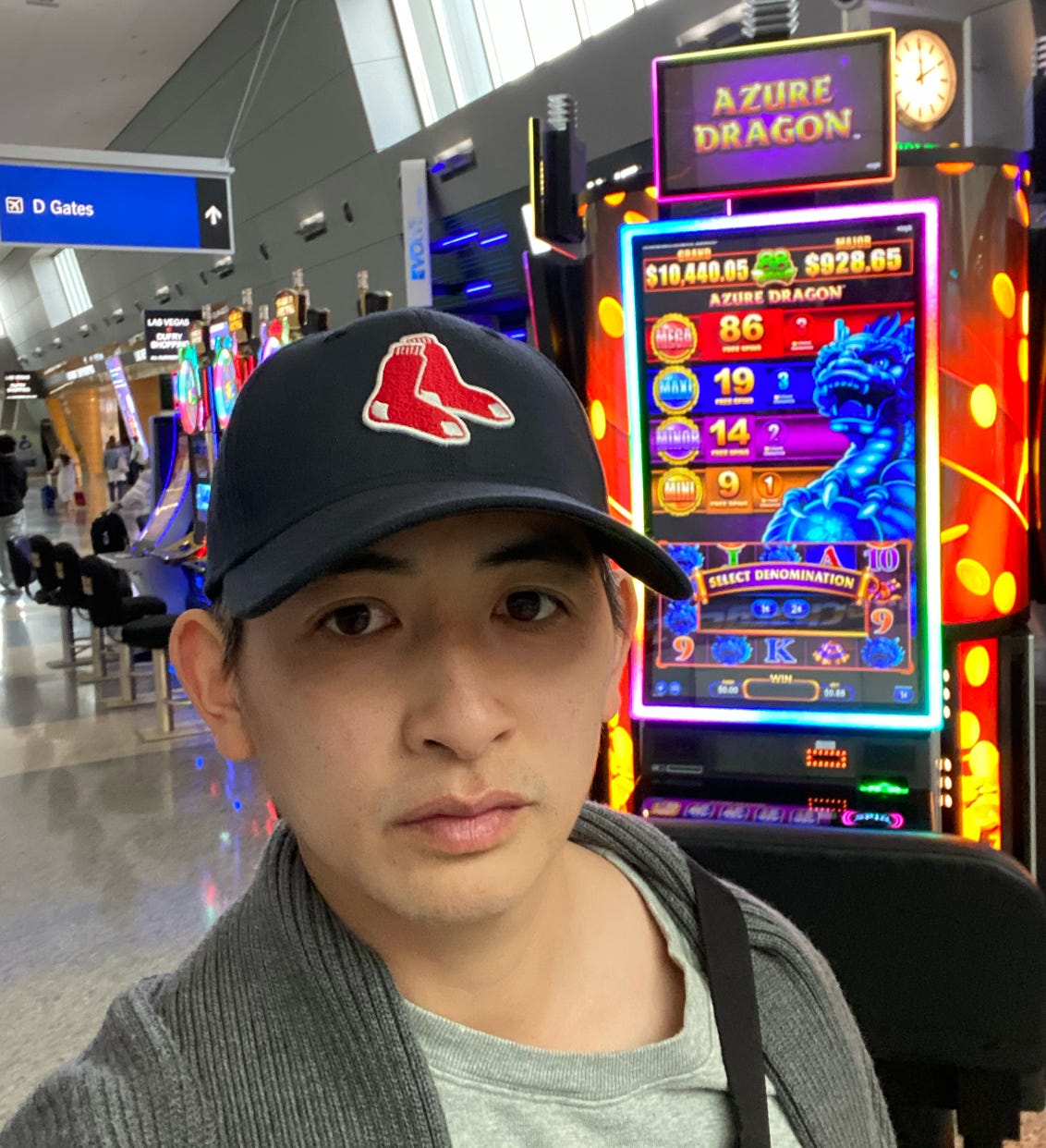
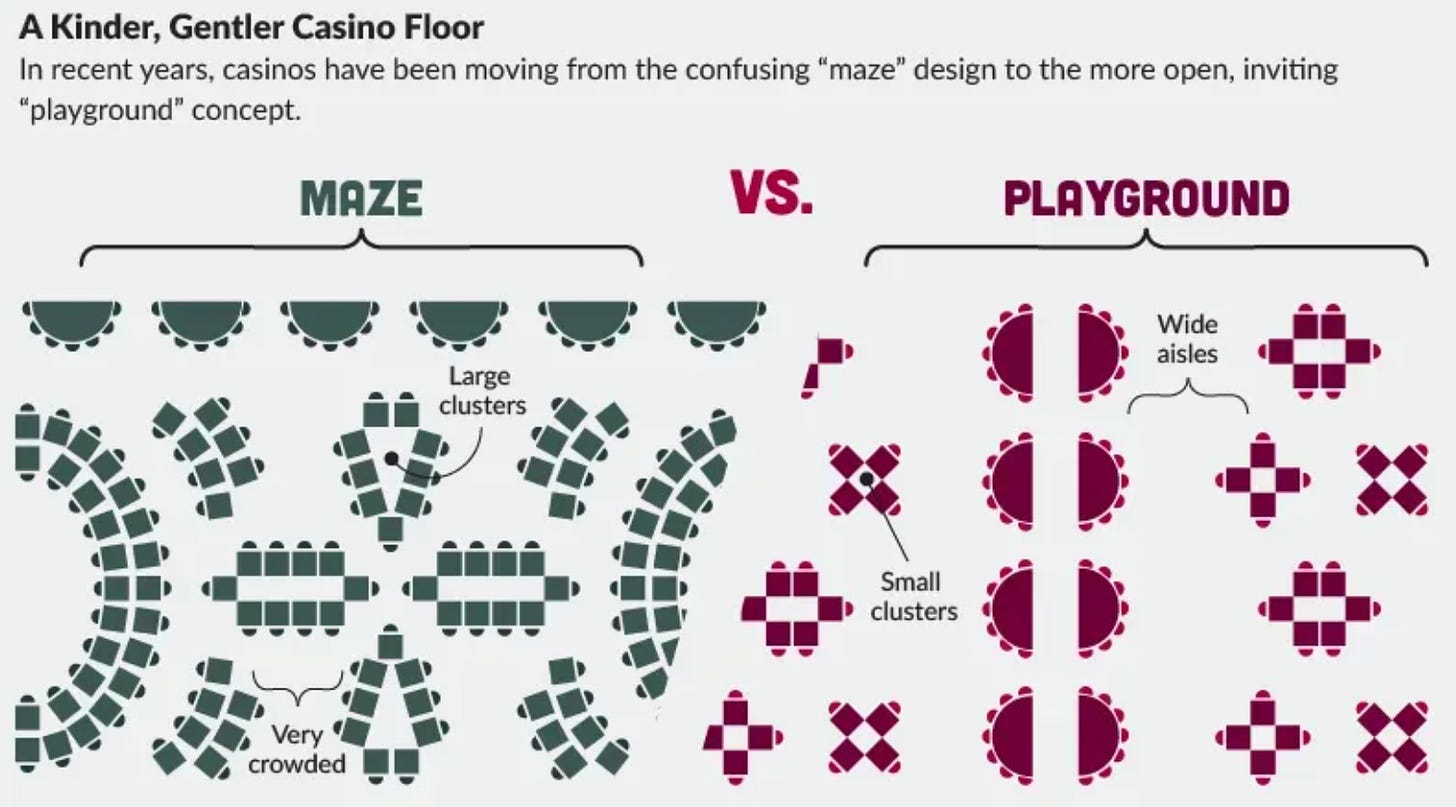
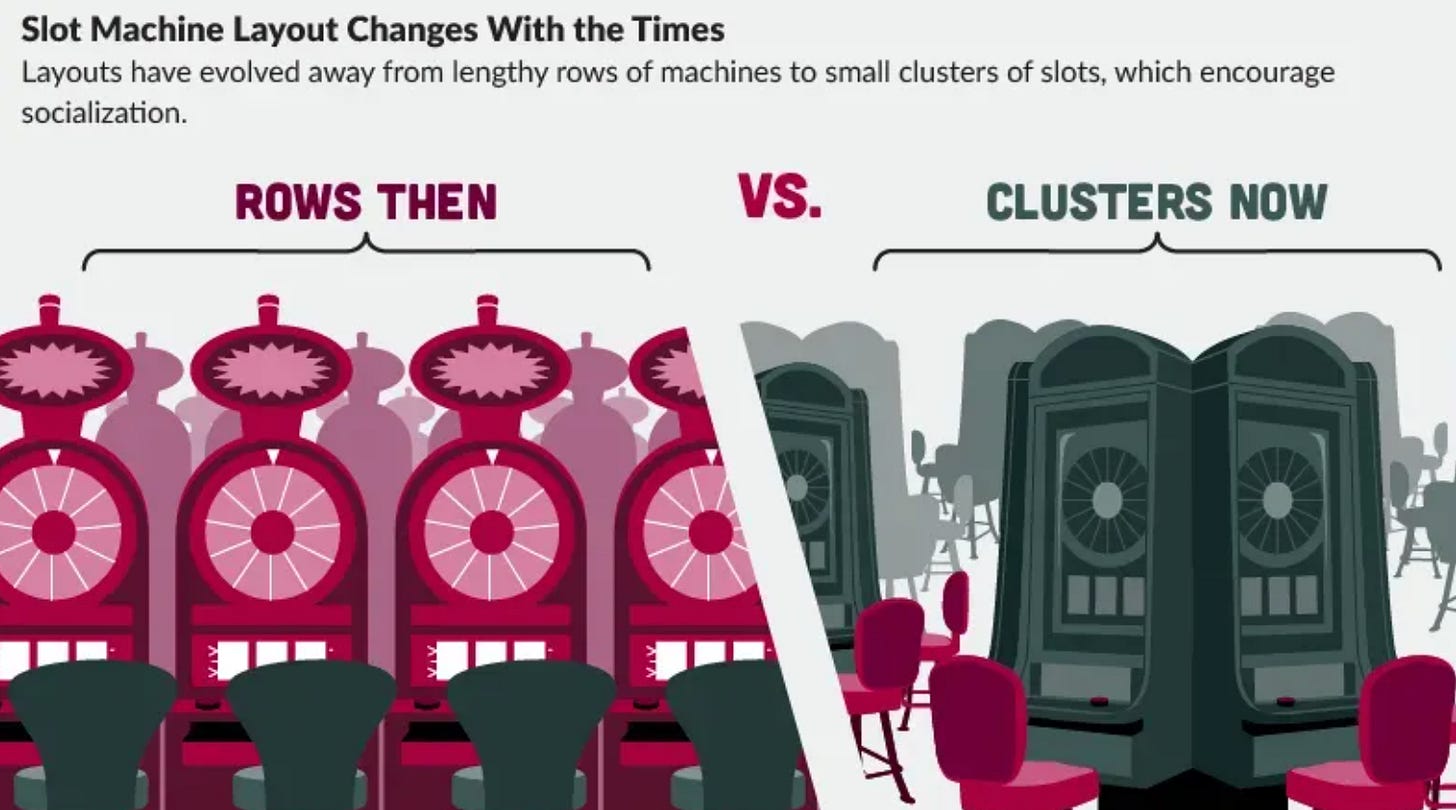
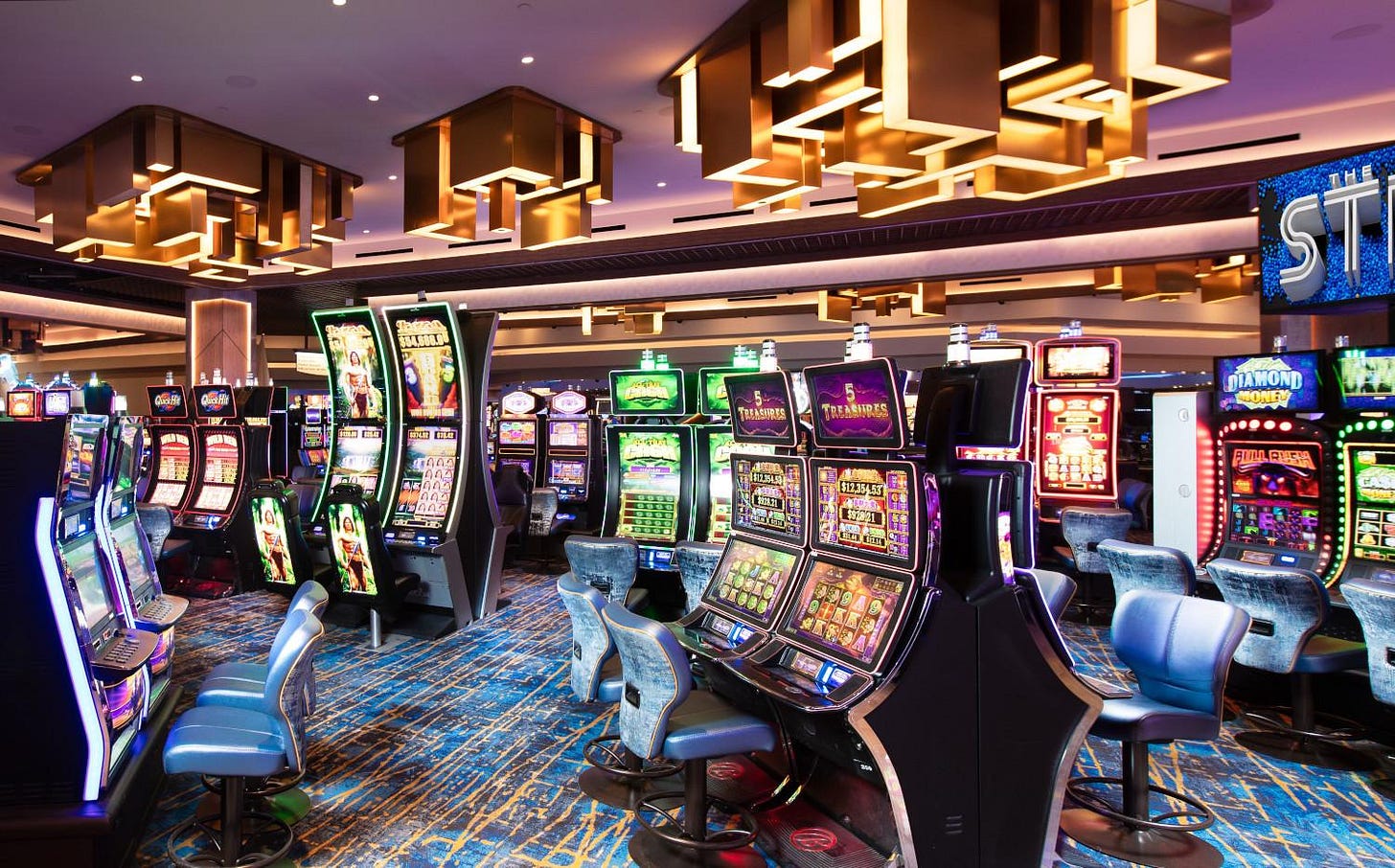
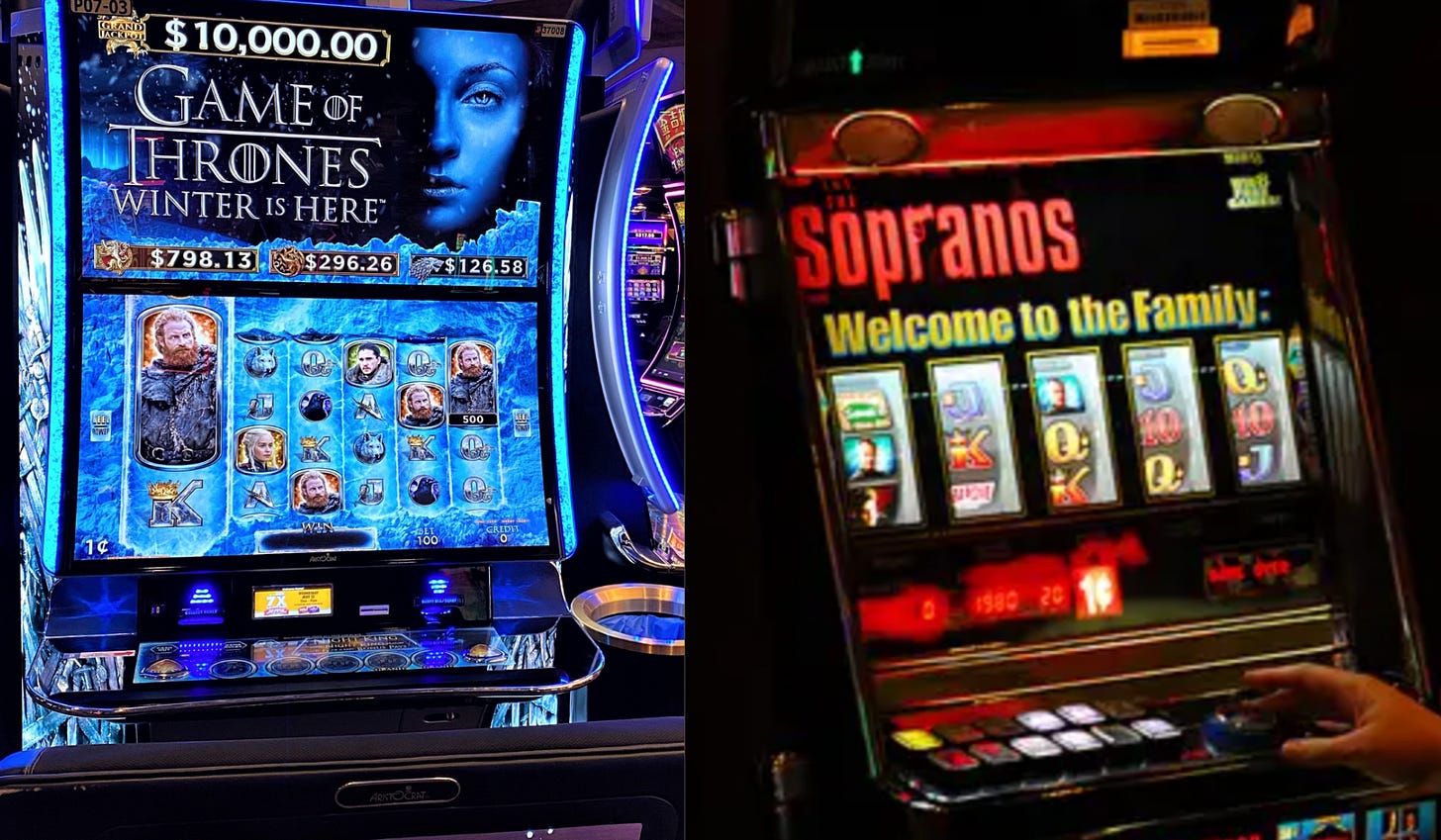
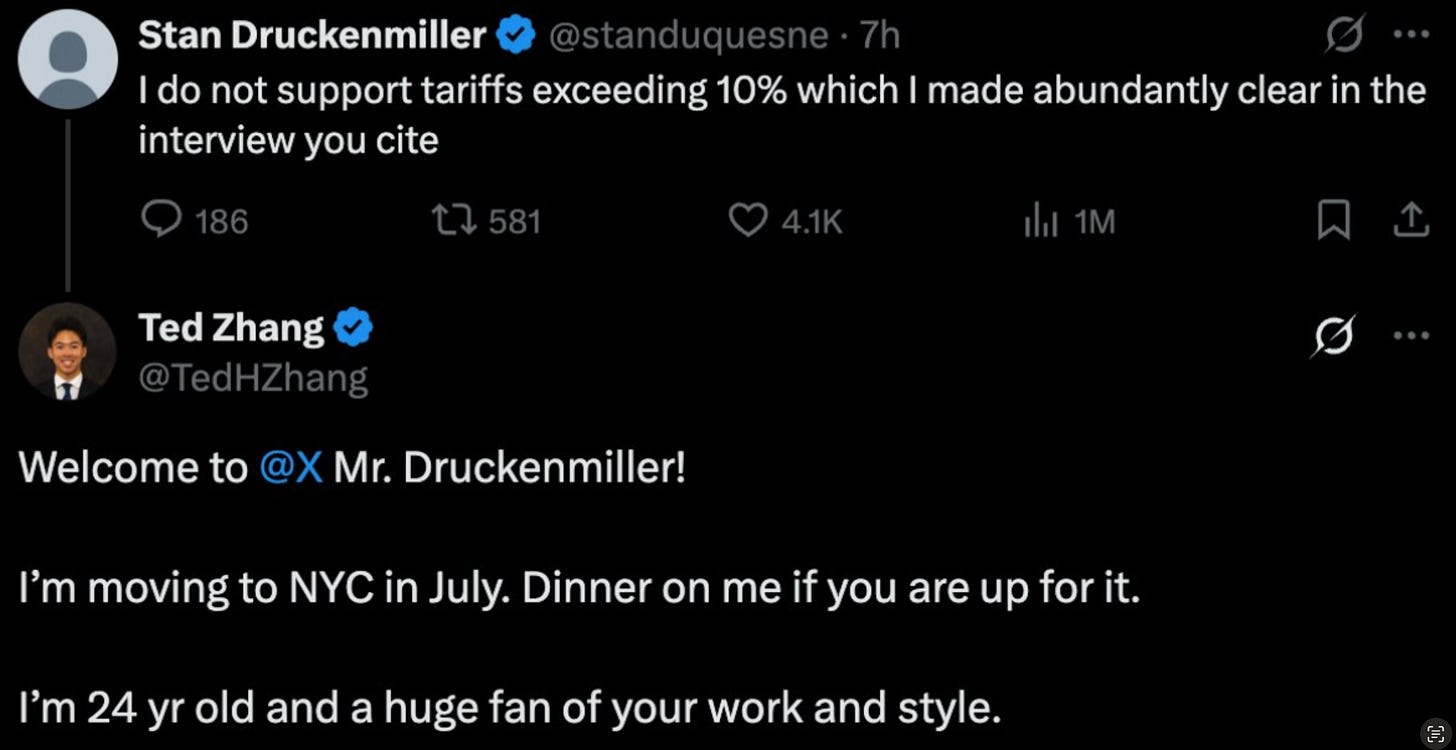
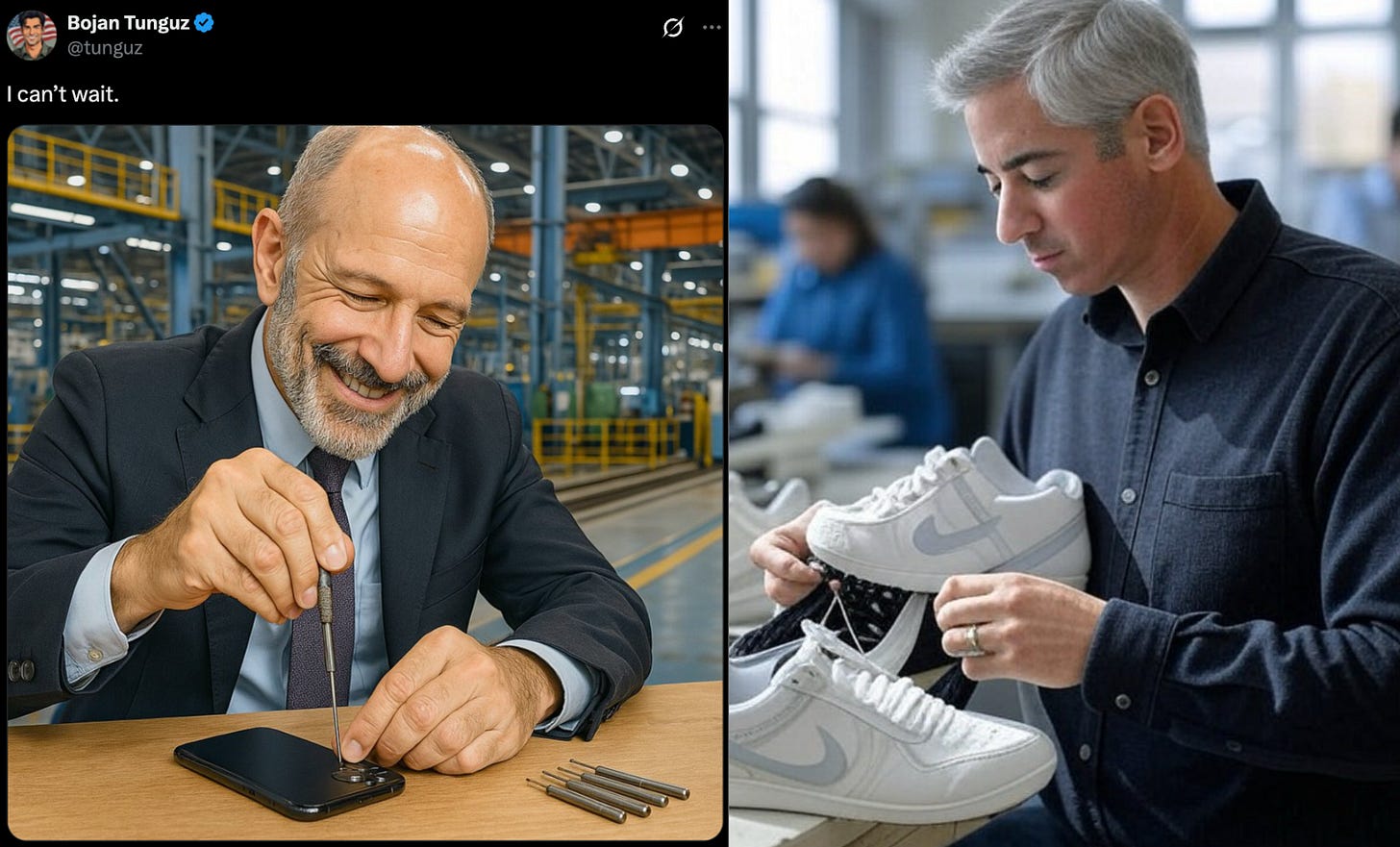




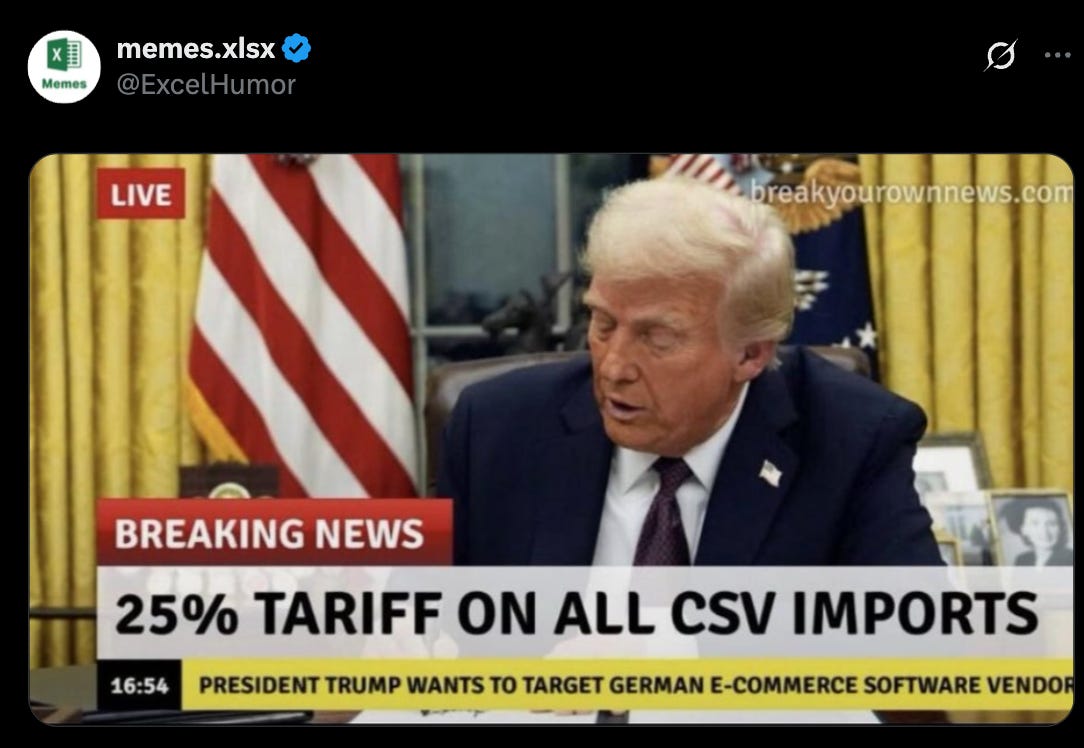

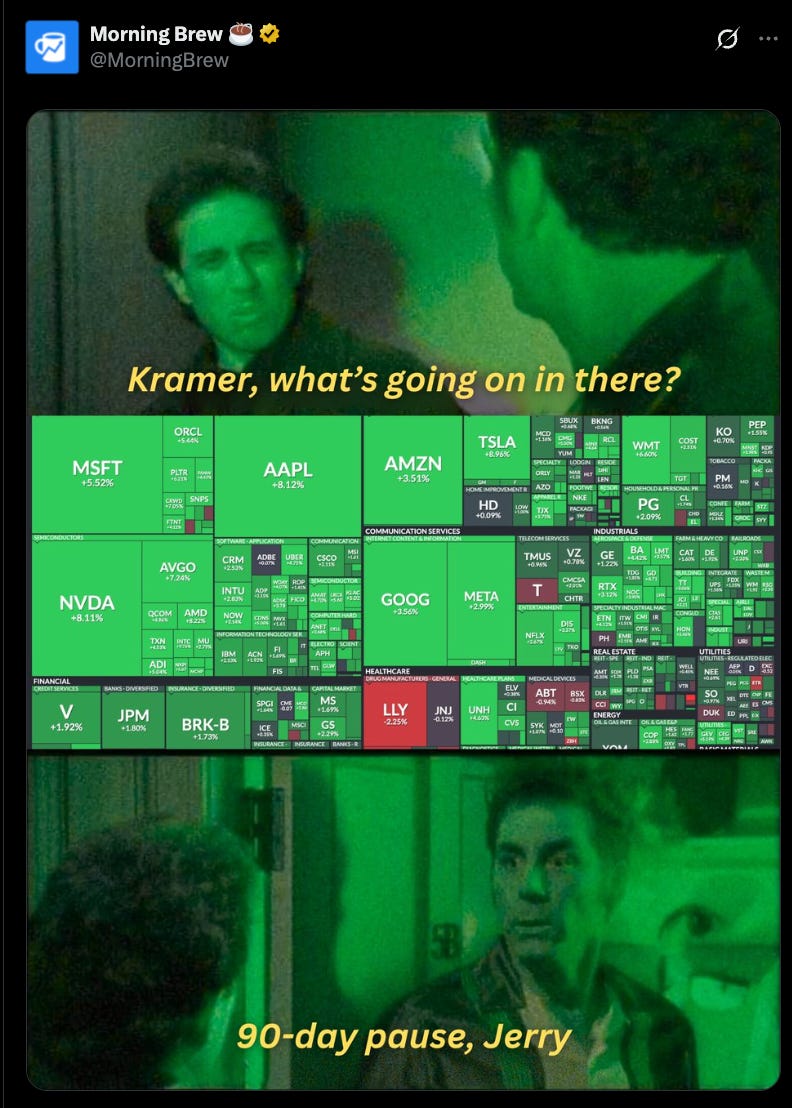
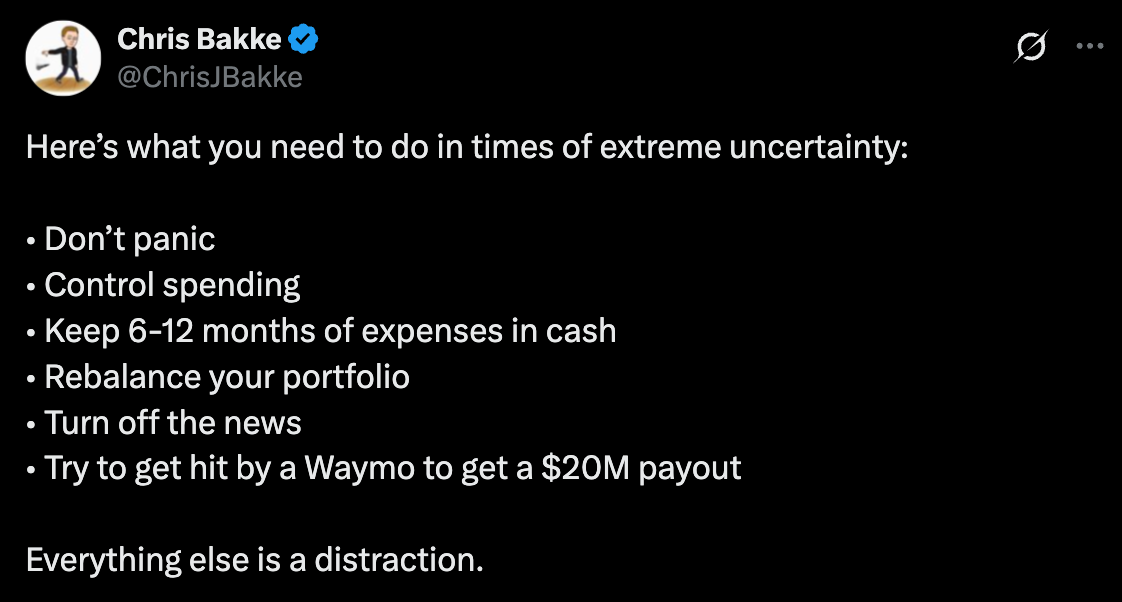
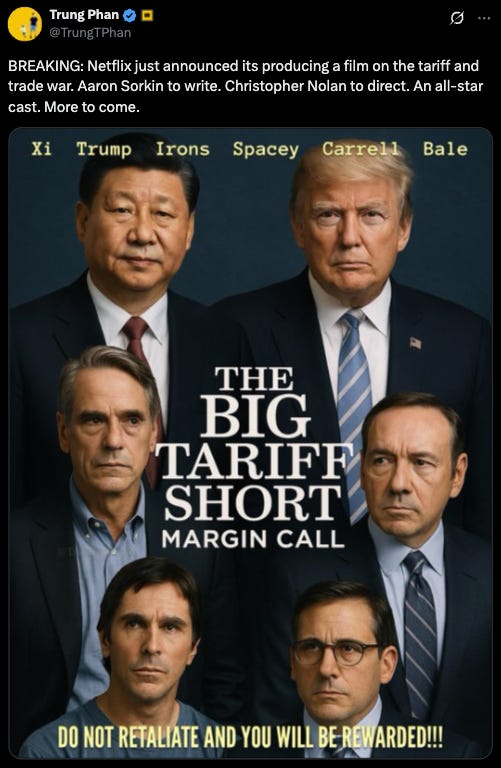

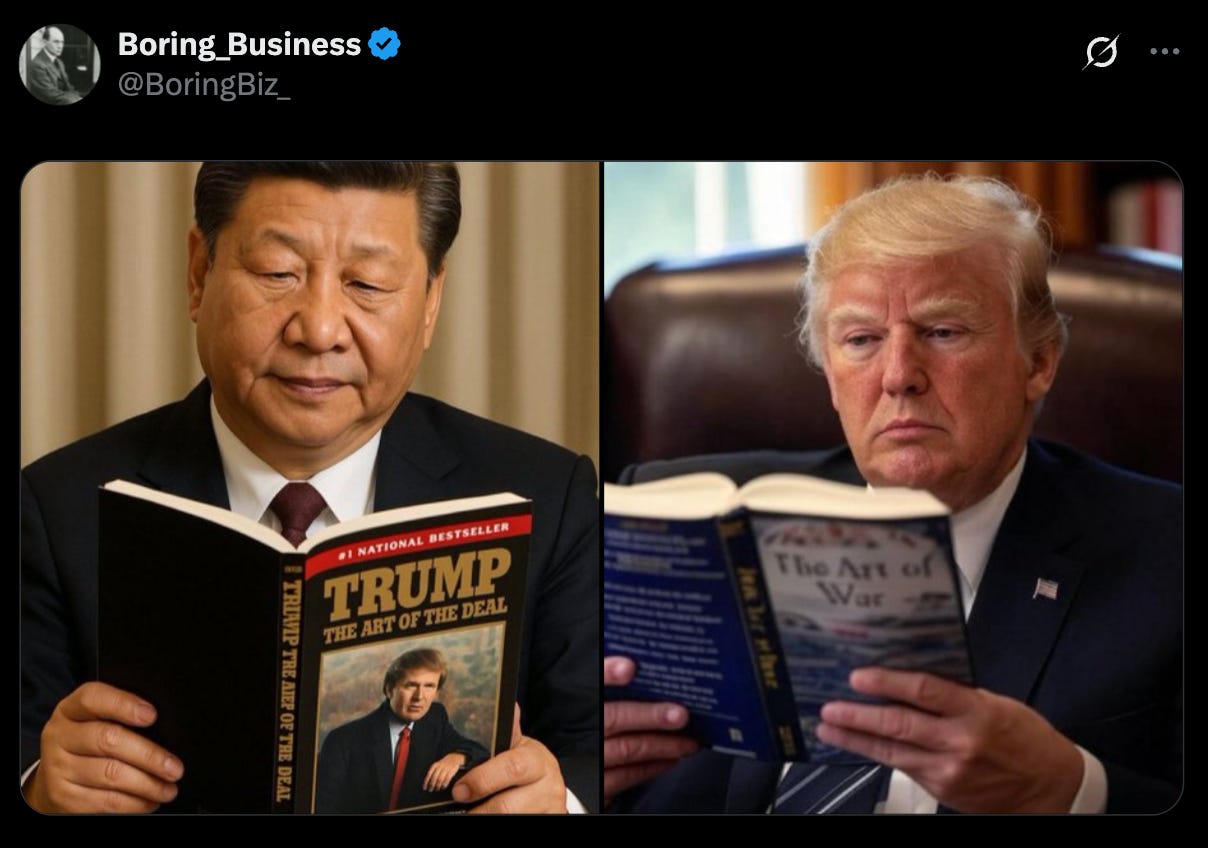


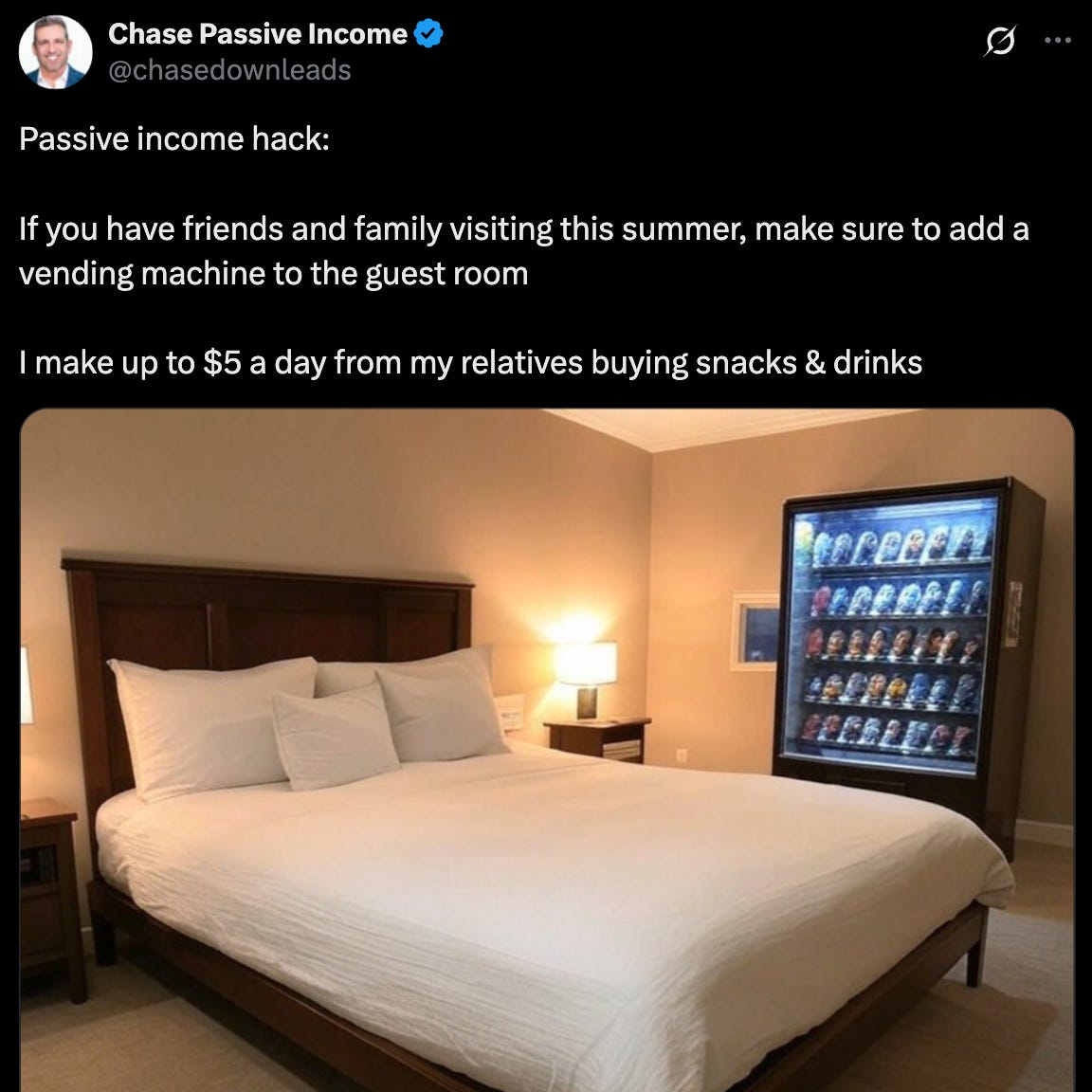
Thanks for making every Saturday morning educational and funny as hell :-)
Two great articles in one long SatPost. A lot of the ergonomic aspects of the slot machine experience should also be applied to wherever people work on screens all day; I think most offices don't obey the lightning rules, for example, 'saving money" on lower-cost lighting that is more tiring. I used to manage CAD operators and set up "CAD Rooms" with lower lighting and indirect incandescent (avoids the flicker of fluorescent bulbs) lights. It made for a much less taxing environment.